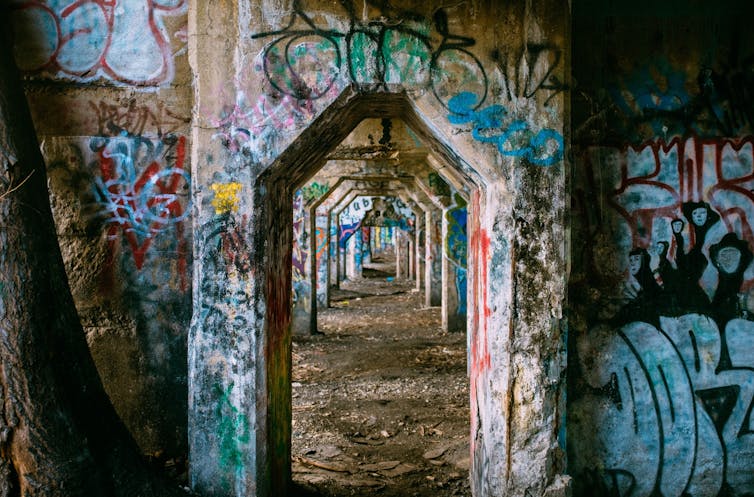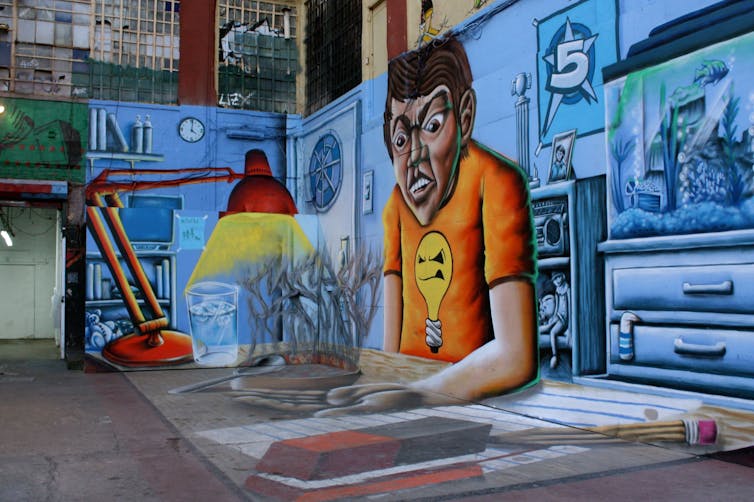The Evolution of Graffiti: How Street Art Gained Social Acceptance

Ashim D’Silva for Unsplash.com, CC BY-SA
Graffiti has become so mainstream in recent years that auction houses, museums and entire art shows cater to street art connoisseurs and collectors around the world. Images in the news of young vandals responsible for marking walls have been replaced by sleek websites belonging to global phenoms such as Banksy and Shepard Fairey.
In cities around the world, graffiti is now associated with “street artists” rather than violent street gangs. Today, many cities, from Pittsburgh to Pretoria, invite street artists to help brand neighborhoods that are being revitalized and gentrified as legitimately hip destinations for business owners, home buyers and influencers. Some up-and-coming neighborhoods in cities like Dakar, Senegal; Mexico City; Brisbane, Australia; and Seoul, South Korea offer street art tours and host graffiti festivals.
The vibrantly colored walls in such places attract travelers to parts of town once deemed “sketchy.” These same neighborhoods are home to bookstores that carry graffiti coffee table books and universities that offer courses on graffiti art. I have taught such courses myself. But it hasn’t always been this way.

Julie Ricard for Unsplash.com, CC BY
The history of tagging
Before becoming an academic who teaches and writes about graffiti, I was a graffiti writer. I started tagging, or illegally writing my name — Cisco CBS — on surfaces across Los Angeles in the early 1990s.
At the time, local governments were cracking down on wall writers with anti-gang legislation, such as California’s 1988 Street Terrorism Enforcement and Prevention Act, and a variety of “broken windows theory” policing initiatives.
Law enforcement didn’t seem to understand what the writing on walls meant or who was behind those cryptic images and personal monikers. Many residents couldn’t read or understand it either. Graffiti was interpreted as gang-related and, therefore, territorial and violent. Vandals were targeted with well-funded anti-graffiti task forces and police crackdowns on taggers like me.
It was not enough, it seemed, to rightfully charge graffiti writers with vandalism. Rather, police and district attorneys, backed by a morally panicked public, were making an example of graffiti writers, charging them with felonies, giving them six-figure fines and sending them to prison for illicitly marking walls.
By the end of the 1990s, as the violent crime rate in cities across the U.S. declined and gentrification increased, new residents felt they could safely move into lower cost, “up-and-coming” neighborhoods.
Local governments turned to gang injunctions, a restraining order targeting alleged gang members, to help rid neighborhoods of the remaining taggers and wall writers who were labeled gang members and were painting political wall murals.
The Guadalupe, or La Virgen, was used to signal the Chicano community’s faith in God’s protection, delivering them from the violence of the streets at the hands of gangs and police alike. But such murals, often done by local graffiti artists who were themselves deeply rooted in the Chicano community, were forced to make room for “street art” in the context of neighborhood change and urban redevelopment.
As real estate prices went up, the Guadalupe murals came down, symbolizing local displacement by gentrification. While physical displacement was being experienced firsthand by long-standing residents, the transformation of the walls in these communities symbolized a broader cultural change. By the early 2000s, politically neutral street art images replaced depictions of social struggle, Chicano/a history, and community life.
Graffiti made legit
By 2011, the Museum of Contemporary Art in Los Angeles hosted the first-ever museum survey of street art and graffiti. At this time, I was finishing my dissertation on the “Changing Face of Wall Space,” which explored graffiti in the nearby neighborhoods of Echo Park and Silver Lake. In it, I analyzed how graffiti writers such as Eyeone, Mear and Cache were navigating the legal, social, economic and cultural shift taking place in Los Angeles. In the midst of this struggle over wall space and aesthetics, many of my friends were invited inside to tag the walls of the Art in the Streets exhibition.
Just outside the museum gallery, the newly branded Arts District soon welcomed muralists and graffiti writers from around the world. These were the same streets where many of us had been chased, beaten and arrested by police for doing what was now fashionable and profitable. Los Angeles, like many cities in the U.S., had the lowest homicide rate in more than a generation. In this new context, it became more difficult to connect graffiti to the gangs: Gang violence just wasn’t there. Graffiti had made a comeback, arriving inside the Trojan Horse of legitimate street art.
Urban blight or community history
Self-described critical Chicana muralists, such as Judith Baca, and pachuco graffiti writers such as Chaz Bojórquez, had been painting on walls around Los Angeles as early as the 1970s. These wall artists’ styles were often maligned by city leaders, business owners and wealthy Anglos. But something changed when these inner city aesthetics became the mainstream backdrop for arts communities.
No longer does the writing on the walls signal blight and disorder. Rather, graffiti increasingly tells the story of urban change. It took seeing it as “safe” in the form of “street art” for people to start paying attention to its visual power.![]()
This article is republished from The Conversation under a Creative Commons license. Read the original article.

0 Comments:
Post a Comment
Subscribe to Post Comments [Atom]
<< Home